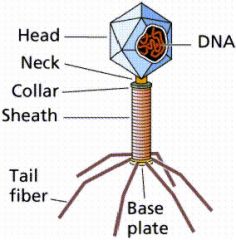![]()
![]()
![]()
Use LEFT and RIGHT arrow keys to navigate between flashcards;
Use UP and DOWN arrow keys to flip the card;
H to show hint;
A reads text to speech;
8 Cards in this Set
- Front
- Back
|
What is the simple way in which viruses infect? |
1. Once inside the cell, nuclear material causes host cell to make new viruses 2. Host cell burst and dies 3. New viruses escape from the cell and prepare to do the same thing with others. |
|
|
What is an example of a viral disease? |
Aids, Influenza or Measels |
|
|
What is one of the cycles of the virus called? |
The Lyctic Cycle |
|
|
Explain the first three steps of early infection in the Lyctic Cycle? |
1. Virus attaches to the bacterium 2. Virus injects DNA into bacterium 3. Viral DNA uses cellular machinery to reproduce itself |
|
|
Explain the last three steps of late infection in the Lyctic Cycle? |
4. Components of the viral protein coat are produce from genes in the viral DNA 5. Viral particles self assemble into new viruses 6. Viruses overrun the host cell and burst free, lysing and killing the cell |
|
|
Why are viruses difficult to classify? |
Viruses are difficult to classify as not only do they possess a different structure to any other organism in the kingdoms. Their is also some debate as to whether or not they are in fact living. They are unable to reproduce or survive without a host, nor do they possess many of the necessary requirements of a cell. |
|
|
What is unique about viruses? |
They are very small and only visible with an electron microscope They are NOT CELLS- only RNA and DNA enclosed in a protein coat They reproduce inside other cells. |
|
|
Describe the structure of a virus? |

|

